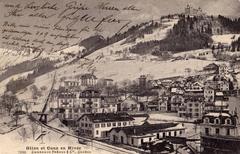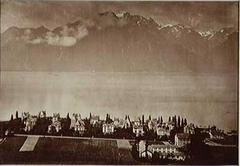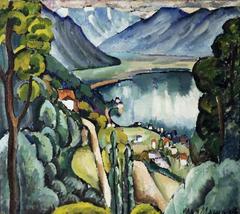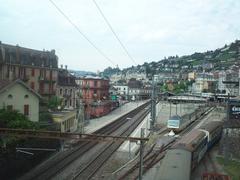Visiting Caux Montreux, Switzerland: Comprehensive Guide to Tickets, Hours, and Attractions
Date: 15/06/2025
Introduction: Caux Montreux Overview and Significance
Perched high above the sparkling shores of Lake Geneva in the canton of Vaud, Caux is a picturesque mountain village celebrated for its panoramic vistas, Belle Époque heritage, and the iconic Caux Palace Hotel. Completed in 1902 by architect Eugène Jost, the Caux Palace is a prime example of Swiss architectural grandeur and a monument of cultural significance. Originally a modest settlement near the Jaman Pass, Caux transformed into a renowned alpine resort in the late 19th and early 20th centuries, drawing royalty and aristocracy in search of tranquility and natural beauty. Today, the Caux Palace is not only a testament to the region’s golden era but also a center for global peacebuilding and dialogue, operated by Initiatives of Change.
Visitors to Caux and nearby Montreux can immerse themselves in a rich array of experiences—from guided tours of the palace and its historic theatre to lakeside walks, mountain railways, and the exploration of medieval landmarks like Château de Chillon. Whether arriving by the scenic cogwheel train or the winding Jaman Pass road, Caux offers a harmonious blend of nature, history, and vibrant cultural life, making it a highlight of the Swiss Riviera.
This guide delivers detailed information on visiting hours, ticketing, transportation, accommodations, and travel tips, ensuring a seamless and memorable visit. For the most up-to-date details, check the official Caux Palace Hotel website and the Montreux tourism portal.
Discover the unique fusion of history, culture, and alpine beauty that defines Caux and Montreux. (myswitzerland.com; montreux.ch; cauxpalace.ch)
Table of Contents
- Introduction
- Historical Overview of the Caux Palace Hotel
- Visiting the Caux Palace Hotel
- Getting to Caux and Montreux
- Nearby Attractions in Montreux
- Accommodation and Dining
- Outdoor Activities and Natural Setting
- Visitor Tips and Practical Information
- Frequently Asked Questions (FAQ)
- Conclusion
- Sources
1. Historical Overview of the Caux Palace Hotel
Belle Époque Origins
Caux’s transformation began in the late 19th century with the development of luxury hospitality. The Grand Hôtel de Caux opened in 1893, but it was the Caux Palace, inaugurated in 1902 by Eugène Jost, that established the village as an exclusive alpine retreat (myswitzerland.com; fr.wikipedia.org). The palace’s flamboyant architecture, extensive terraces, and lavish interiors quickly made it one of Switzerland’s grandest hotels.
The Main Hall, baroque theatre, and ornate facades remain central to guided tours today. The palace’s romantic silhouette has also featured in media, including as a filming location for the Netflix series “Winter Palace” (myswitzerland.com).
Wartime Roles and Postwar Transformation
The outbreak of World War I marked the end of Caux’s golden age as a luxury resort. During World War II, the Caux Palace sheltered internees and refugees, reflecting its humanitarian commitment (fr.wikipedia.org). In 1946, it was repurposed as a center for peace and reconciliation by Swiss citizens and international volunteers, eventually becoming the headquarters of the Moral Re-Armament movement, now Initiatives of Change. The palace has since hosted international conferences and is home to the Swiss Hotel Management School (foranewworld.org; cauxpalace.ch).
2. Visiting the Caux Palace Hotel
Hours, Tickets, and Guided Tours
- Opening Hours: Guided tours are available from April to October, typically 10:00 AM to 5:00 PM. Check the official website for seasonal variations.
- Tickets: CHF 15–20 for adults; discounts for children, students, and seniors.
- Booking: Advance booking is advised, especially during peak periods and for groups.
Visitor Experience
Guided tours offer access to the Main Hall, baroque theatre, and historically significant areas such as the old laundry and workshops. The terraces present outstanding panoramic views of Lake Geneva and the Alps, ideal for photography and quiet reflection. Special events and conferences are held throughout the year; details are available on the palace’s events calendar.
3. Getting to Caux and Montreux
By Train
Caux is easily reached from Montreux via the Montreux–Glion–Rochers-de-Naye cogwheel railway (MVR). The scenic 20-minute ride offers breathtaking views. The Caux station is a short walk from the palace (meetings.embo.org).
By Car
The drive from Montreux via the Jaman Pass is well-signposted but includes winding mountain roads. Parking is available near the palace.
Accessibility
The Caux Palace and cogwheel train are partially accessible. Some areas, especially in the historic building and village, may present challenges for those with limited mobility; contact the venue in advance for accommodations (iofc.ch).
4. Nearby Attractions in Montreux
Château de Chillon
This 12th-century lakeside castle is one of Switzerland’s most visited historical sites. Open daily (9:00 AM–7:00 PM in summer; 10:00 AM–5:00 PM in winter), it features guided tours, exhibitions, and spectacular lake views (myswitzerland.com).
Montreux Lakeside Promenade
The flower-lined lakeside promenade is ideal for walking and cycling, adorned with sculptures and the famous Freddie Mercury statue.
Rochers-de-Naye Railway
The cogwheel railway ascends to 2,042 meters, offering access to Marmot Paradise and a network of hiking trails (myswitzerland.com).
5. Accommodation and Dining
Staying in Caux
- Caux Palace: Functions primarily as a conference and school campus; overnight stays are not generally available to tourists (cauxpalace.ch).
- Le CouCou Montreux: Boutique hotel with panoramic views (myswitzerland.com).
In Montreux and Nearby
- Fairmont Le Montreux Palace: Luxury 5-star lakeside accommodation.
- Tralala Hotel: Music-themed boutique hotel.
- Jugendherberge Montreux: Budget hostel.
- Hôtel Masson: Historic charm in Veytaux.
- Grand Hôtel du Lac and Hôtel Des Trois Couronnes: Upscale options in Vevey.
Dining
Caux has no shops or restaurants; plan to eat in Glion or Montreux. Notable options include Auberge de Sonchaux, Le Pont de Brent (Michelin-starred), and lakeside restaurants in Montreux and Vevey (myswitzerland.com).
6. Outdoor Activities and Natural Setting
Hiking and Panoramic Views
Caux offers numerous hiking trails, such as those leading to Dent de Jaman and Rochers-de-Naye. The observation deck at the palace provides breathtaking views (evendo.com).
Winter Sports
In winter, enjoy cross-country skiing, a natural ice rink, and access to ski lifts at Rochers-de-Naye. The village also has a history of hosting international winter sports events (fr.wikipedia.org).
7. Visitor Tips and Practical Information
- Best Time to Visit: Late spring to early autumn for hiking and wildflowers; winter for skiing and skating.
- Weather: Caux is cooler than Montreux; pack layers and a rain jacket.
- Transport: The Montreux Riviera Card gives visitors free access to local transport (meetings.embo.org).
- No Shops in Caux: Stock up on essentials in Montreux or Glion before visiting.
- Language: French is predominant; English widely understood.
8. Frequently Asked Questions (FAQ)
Q: What are the opening hours of the Caux Palace?
A: Guided tours run from 10:00 AM to 5:00 PM, April–October. Confirm on the official website.
Q: Are tickets required for entry?
A: Yes, tickets are required for guided tours and can be booked online or at the palace.
Q: Is the Caux Palace accessible for wheelchairs?
A: Partial accessibility; contact ahead for specific needs.
Q: Can I stay overnight at the Caux Palace?
A: The palace operates primarily as a conference and school center; overnight stays for tourists are not generally available.
Q: Are there shops or restaurants in Caux?
A: No; plan to dine in Glion or Montreux.
9. Conclusion
Caux and Montreux are destinations where history, culture, and nature converge. From the majestic halls of the Caux Palace to the vibrant lakeside promenades and medieval castles, the region offers a wealth of year-round attractions and experiences. Plan your visit by checking current opening hours and securing tickets in advance. Use the Montreux Riviera Card for easy local transport, and download the Audiala app for real-time updates, guided tours, and insider tips. Embark on your journey to discover the unique magic of Caux and Montreux, where Swiss heritage and alpine splendor await.
10. Sources
- Caux Palace Official Website
- MySwitzerland - Visit of the Caux Palace
- Montreux Village Information
- Montreux Tourism Portal
- Swiss Destinations - Caux
- EMBO Meetings - Caux Travel Info
- Traveling Season - Montreux Guide
- For A New World - Caux Belle Époque
- Initiatives of Change
- Wikipedia - Caux (Montreux)
- Evendo - Caux Palace
- Wonderful Wanderings - Montreux
- Touring Highlights - Montreux





